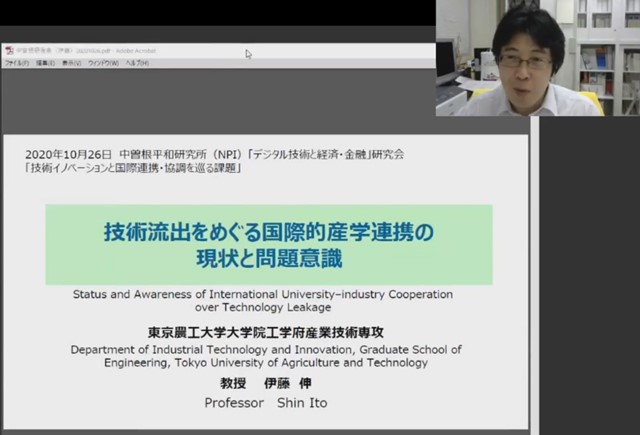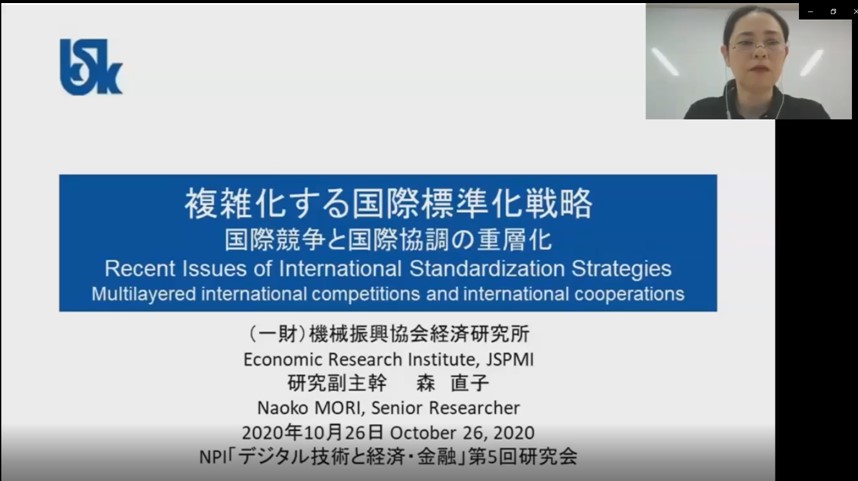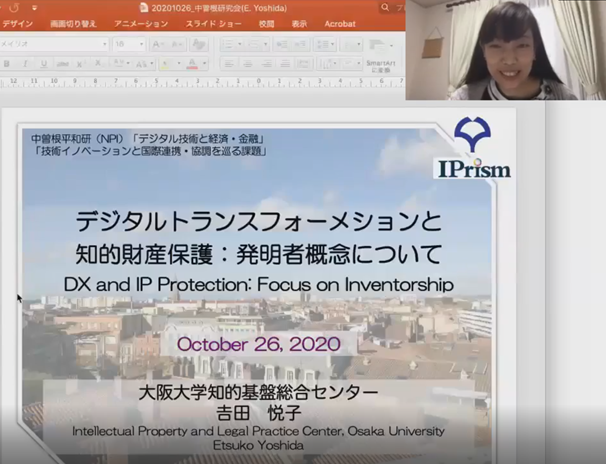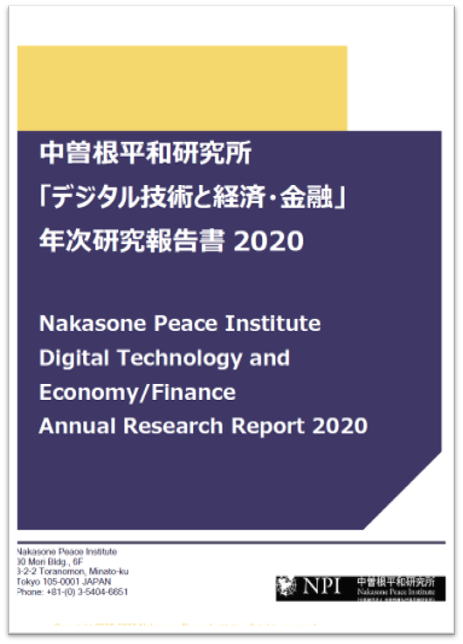2020/11/16
"Challenges in Technological Innovation with respect to International Cooperation and Collaboration " ("Digital Technology and Economy/Finance" Study Group)
The Nakasone Peace Institute held the web conference on "Challenges in Technological Innovation with respect to International Cooperation and Collaboration" with Prof. Shin Ito (Professor, Graduate School of Engineering, Tokyo University of Agriculture and Technology) , Ms. Naoko Mori (Senior Researcher, Economic Research Institute, JSPMI), Ms. Etsuko Yoshida (Research Fellow, Intellectual Property and Legal Practice Center, Osaka University), and other regular members, on October 26th 2020.
1 Presentation "Status and Awareness of International University industry Cooperation over Technology Leakage" (Prof. Ito)
■Increasing importance of confidential information management in universities and the need for a balanced approach
Recent developments regarding technology leakage from universities can be seen in the Integrated Innovation Strategy 2020 (approved by the cabinet on July 17), which includes measures to prevent technology leakage through the cooperation of related government ministries and agencies, stronger screening of foreign students and researchers, and the disclosure of information on foreign funding for research.
As industry-government-academia cooperation is becoming more and more popular every year, the importance of confidential information management in universities is also increasing. Originally, the mission of universities was to make their research results public, but in the process of industry-university cooperation, they sometimes receive confidential information from companies. Since joint inventions also occur, there is a growing need for a well-balanced approach to the management of such information, such as "physical isolation" and "maintenance of trustworthy relationships (including with invited researchers and international students)" on the other hand.
■Balancing freedom of research and security trade control in internationalized universities
With the internationalization of universities (increased international collaboration among researchers), there is a growing necessity for research resource management from the perspective of export control and security trade control, including compliance with the Foreign Exchange and Foreign Trade Act. The systematic initiatives at Nagoya and Mie Universities since 2015 are becoming a model for other domestic universities.
Although universities tend to have a high degree of mobility of human resources across borders (and the associated mobility of technology and research) because of their mission to educate and research, only a few have had adequate organizational management systems in place to deal with this. This is an urgent need to be strengthened from the perspective of maintaining research freedom, complying with laws and regulations, and avoiding reputation risk.
■Differences between the U.S. and Japan in terms of defense and national interests in research and intellectual property, and Japan's approach
In the U.S., due in part to the impact of the National Defense Authorization Act enacted in 2018, the trend of reviewing industry-academic collaboration with Chinese companies in universities is continually being seen.
One of the legal difference between the U.S. and Japan over the relationship between intellectual property and national interests is the introduction of a "secret patent system" under U.S. law, in which sensitive technology for security purposes is not disclosed, while Japanese law does not have a similar provision.
At present, we are facing both industrial competitiveness and security issues at the same time, and it is necessary to balance the promotion of innovation and the prevention of technology leakage. Measures to ensure academic freedom and prevent unfair discrimination against foreign students are, of course, essential, but the situation is constantly changing, and it is unclear how collaborative research with other countries (i.e., provision of technological seeds from the perspective of universities) should be conducted. Under such circumstances, it is increasingly important for Japanese universities to have a support system of research assistance departments and industry-academia collaboration departments that have specialized knowledge and skills.
2 Presentation "Recent Issues of International Standardization Strategies -Multilayered international competitions and international cooperations " (Ms. Mori)
■Layering of Cooperation and Competition Domains by Technological Innovation
International standardization has been carried out since the middle of the 19th century in such fields as industrial goods and communications. International standardization has established itself as a cooperative domain through friendly competition with the role of intellectual property and patents in the "competitive domain," but at the same time, the initiative process of international standardization has sometimes been transformed into a competitive domain, and international standardization organizations that have been established in different fields have cooperated with each other as necessary.
In the current international standardization competition, along with the progress of the Internet of Things (IoT), the multilayered nature of the cooperative and competitive domains is becoming more prominent.
■Trends in the U.S. and Europe: Focusing on the "system-in-system" concept
In the United States, the Team of Rivals Principles exist as an industrial policy, as well as the activities of digital platforms such as GAFA.
Here, for the purpose of ensuring interoperability, major companies share a multilayered overview of technologies and systems (the concept of system-in-system), discuss areas of cross-industry collaboration, jointly design an architecture for system collaboration, and establish a cooperative system for promoting the IoT and promoting de facto standards.
In Europe, the fundamental structure of the desired system has been defined as a reference architecture for the resolution of common and social issues that transcend the boundaries of industries and companies, and the areas in which existing and new standards should be utilized at each layer of the system have been defined (e.g., Industry 4.0 in Germany, which is also a standardized architecture, with system-in-system idea).
■China's Moves: "China Standard 2035" as a World Strategy, and the Challenges for Japan
China is in the process of formulating China Standard 2035, which is a step forward from the existing China Manufacturing 2025. Unlike the U.S. and Europe, China Standard 2035 is a "national project" that clarifies the use of standards in strengthening international competitiveness and international influence.
As a latecomer to the project, China is learning from Germany and other countries about international standardization activities and how to use international standards as a nation, and is investing money and human resources to underwrite the leadership of a number of international standardization organizations and to propose the establishment of committees. In other words, the "strategy for technological hegemony" is coming to the fore.
It is an attempt to turn both the domain of international competition and the domain of cooperation into an advantage for China, by strongly encouraging patent applications and at the same time trying to promote international standards.
In comparison to the other countries, Japan's Society 5.0 efforts have yielded little progress in the development of the cooperative and competitive domains that are the primary keys to international standardization. The goal setting seems to be vague, and the design of an architecture to carry out these goals is not visible.
3 Presentation "DX and IP Protection: Focus on Inventorship" (Ms. Yoshida)
■Intellectual Property Rules and Issues Regarding AI (Artificial Intelligence)
The development of rules for patent applications, intellectual property, and other matters related to artificial intelligence (AI) has become increasingly significant in both Japan and Europe since around 2016. In particular, with regard to the development of rules, Europe is leading the way in terms of international harmonization, especially in guidelines and ethics, so Japan is also aware of this trend and is taking action with attention.
Meanwhile, although AI is capable of storing, calculating and generating a variety of information, it does not provide answers based on the meanings of the information. Therefore, under current intellectual property law, AI is NOT the subject of a rights entity. It is only the "human being" who uses it as a tool to "invent" as "creation of technical ideas" that is the subject of rights.
Last year 2019, patent applications by AI (DABUS) made a big splash in Europe and the US. The World Intellectual Property Organization (WIPO) and other institutes are debating whether to recognize AI as an inventor.
■Could AI qualify as an ultimate existence to invent?
Will AI stay as a tool in the future when big data is used more and more in every part of society? Or will it be recognized as an entity to be invented?
Under the current law, the first step could be the disclosure of the requirements for the involvement of AI in inventions. Clarifying the involvement of humans and AI and clarifying the management of inventions could be an opportunity to reconsider the concept of joint inventions. It would also be necessary to harmonize with other countries.
In Japan, there is no clear legal provision on the status of inventors. However, there are two academic theories: the "two-stage theory" which distinguishes between provision of the idea and embodiment of the idea, and the "characteristic partial theory of the invention" which identify a characteristic part of the invention (a part that is fundamental to a problem-solving means specific to the invention); then, identify the person who presented the problem to be solved, the person who devised the means for solving the problem, and the person who confirmed that the problem is solved by the means.
On the other hand, in the U.S., there is a provision in the patent law that defines " The term "inventor" means the individual or, if a joint invention, the individuals collectively who invented or discovered the subject matter of the invention." (Code 100(f)), and since the dispute over the status of the inventor of AI DABUS, as mentioned above, is pending in the district court, the question of how to combine this with AI will be a focus of future discussions.
4 Discussion
■Main Topic 1: Innovation and Technology Management (University Perspective)
○Although university risk management is shifting from the former faculty-centered to organization-centered, it still depends to a large extent on individual efforts on the ground.
The current skills standards for research administrators (URAs) in Japan, which were created in 2014, do not seem to be sufficiently focused on export control and other risk management issues. Discussions are underway with the Ministry of Education, Culture, Sports, Science and Technology (MEXT) and relevant associations to launch an official competency certification system for URAs in the near future.
○So far, one example of a major technology export problem arising from university administration is the 2009 incident at Tohoku University where newspaper reports pointed out that the university was suspected of violating the Foreign Exchange and Foreign Trade Act in connection with its acceptance of Iranian students. There were concerns that the technology might be diverted to the development of nuclear weapons.
At present, there have been no apparent incidents related to the difficulties of joint research due to the confrontation between the U.S. and China, but latent problems could exist.
■Main Topic 2: Innovation and International Standardization (Government and Industry Perspectives)
○The international standardization strategy of each international standard has been discussed in Japan for a long time. However, when it comes to thinking strategically about the expansion of the strategy to a broader area (in accordance with international trends, social issues, and the expansion and multilayered nature of corporate activities), there has not been sufficient discussion that goes beyond the standpoints of the ministries in charge.
In the past, international standardization activities have also been judged based on the following points: "Whether or not the proposal can be put to practical use, the extent to which it has received policy support, and the extent to which it has involved companies." Foreign countries may easily judge such seriousness.
○It is not easy to develop human resources that will contribute to the future strategic development and negotiation of international standards, that is, "international industrial design human resources" who can respond to the structure (architecture) that forms the rules that penetrate the complex, interconnected, multilayered system, only through school education or adult education.
Discussions are needed not only at the Ministry of Education, Culture, Sports, Science and Technology, but also across ministries, and involving related industry associations.
○The strategy and human resource development for international standards needs to be done in 10-year increments. It takes time to identify results, so evaluation does not fit into a short-term HR cycle.
About twenty years ago, there was a time when South Korea and China were working on a pile of standard proposals like a master's thesis presentation. They were chicks at that time, but now they are active in the front line of global standardization, and this seems to have been a long-term human resource development strategy.
On the other hand, the lack of such efforts is a challenge for Japan today. Since it is impossible to deal with them on the corporate level alone, national strategies must be taken.
■Main Topic 3: Innovation and International Standardization (Government and Industry Perspectives)
○In Europe, the debate over AI is varied, not only from technical necessity, but also from constitutional (rights) and ethical aspects. In particular, there is a tendency to focus on the ethical side of the stance, and then consider other aspects as well. There are also those who consider the distribution of benefits between AI and humans as the center of their approach, including the ethical aspects.
In France, a 2018 report led by mathematician-educated politician Cédric Villani touched on the importance of ethics and guidelines in the design of AI, along with the national development strategy and significance of AI. The report has also influenced EU-wide efforts.
○If AI is granted inventive rights, the benefit will probably be attributed tothe person who designed the algorithm. If more than one company is involved in the development of the AI, the allocation of benefits will be an issue.
■Main Topic 4: Innovation and National Security
○The balance between ''open'' and ''closed'' intellectual property is key, but a unique answer is difficult to come up with.
○There is also a great deal of room for development of empirical research on innovation and national security based on past historical events (including Eastern Europe after the end of the U.S.-Soviet Cold War or China's entry into the market economy).
○Since the framework of international organizations for international standardization allows each country to participate openly and equally, it is difficult to pay attention to the security of specific countries individually.
○In Europe, where the debate on intellectual property is deepening, the balance between intellectual property and open innovation is also being discussed, but few people may yet be proposing an overturning of the existing foundations, including a new era of patent systems.








